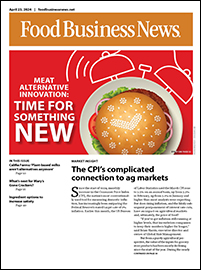KANSAS CITY — Among the major commodity and food ingredient stories of 2024, cocoa easily claimed the headline with record-high prices, followed closely by volatility in eggs from the impact of highly pathogenic avian influenza (HPAI). Corn, soybeans, wheat, sugar and dairy markets were more mundane.
New York cocoa bean futures in 2024 outperformed other commodities from a price standpoint. The nearby New York March futures contract closed at $11,675 per tonne on Dec. 31, up 178% from the Dec. 29, 2023, close of $4,196 per tonne but down from the record high close of $12,565 per tonne on Dec. 18, 2024.
Cocoa bean futures first soared to record highs in April 2024 when it became apparent production in West Africa would be down about 25% from a year earlier. Prices subsequently dropped as the year progressed on forecasts of a rebound in production in the 2024-25 crop year that began Oct. 1. But as weather and other factors developed, it became clear that 2024-25 forecasts were overdone and production likely would not reach expectations, resulting in another year of global deficit cocoa bean supplies.
Cocoa demand held up surprisingly well in 2024, but the trade will be watching quarterly cocoa grind data closely in 2025 as higher prices are passed on to consumers.
Shell egg prices also hit record highs in late December as HPAI outbreaks increased across the prime Midwest production region. Egg product prices also rose sharply but failed to reach record highs set in late 2022, also because of HPAI.
The USDA quoted Grade A large shell eggs at $5.49½ per dozen at the end of 2024, up 151% from a year earlier, with still higher prices posted in early January 2025. Dried whole eggs ended the year up 77%. The greatest impact of HPAI in 2024 was in cage-free and free-range laying flocks that are more susceptible to infection from migratory birds flying overhead.
While HPAI continued to make its greatest impact on the poultry industry, its spread to dairy cattle, hogs and even humans in 2024 was a growing concern.
Dry dairy ingredient prices also crept higher in 2024, but not with the fanfare of cocoa and eggs as the rise was gradual. Nonfat dry milk prices gained 18% on the year, dry whey was up 82% and 34% whey protein concentrate (WPC) gained 59%. An ongoing story in dry dairy products was the lack of production and supply of dry whey and 34% WPC as processors focused on higher-value isolates and higher protein whey. Butter prices eased 3.4% on the year.
The prices for the big three commodities – corn, soybeans and wheat – and related products dropped in 2024, with four-year lows set in some futures during the year as large crops, stiff export competition and a strong US dollar applied pressure.
Nearby CME Group corn futures were down 2.7% for the year, mostly recouping earlier losses on strong export sales and South America crop concerns, compared with losses of 23% in soybean futures, 13% in Kansas City wheat, 12% in Chicago wheat, 18% in Minneapolis wheat, 15% in oats, 16% in soybean oil and 18% in soybean meal.
Flour prices reflected lower wheat prices, with Kansas City standard patent (bread flour) down 19% from 2023, soft wheat flour (cracker and cake flour) down 12% and spring standard patent down 14%. Semolina and cash durum wheat prices both were down about 24% from 2023.
Edible oil prices were mixed in 2024. Nearby March soybean oil futures fell 16% despite strong export sales early in the marketing year. Cash palm oil prices soared 37% and were in rare territory above soybean oil values mainly due to lower production in Southeast Asia, with major buyers such as India supplementing with soybean oil.
Cash refined sugar and raw sugar futures declined as supplies became more available, largely because of soaring imports in 2023-24 (ended Sept. 30), and strong 2024 sugar beet production. Nearby New York world raw sugar futures dropped 6% with domestic raw futures down 7%. Northeast refined cane sugar fell 10% and Midwest beet sugar tumbled 21% in 2024.
Sosland’s Milling & Baking News and Food Business News ingredient indexes reflected the changes in ingredient prices.
The milk chocolate bar index jumped 75% from the end of 2024, with the devil’s food cake index up 35%, both reflecting sharply higher cocoa prices. The vanilla ice cream index was about flat as higher dairy prices mostly were offset by lower sugar prices. But most other indexes were lower. The pasta index tumbled 24% on lower semolina values. The white pan bread index was down 16% and the mayonnaise index dropped 17%. (A full list of the indexes may be found on page 41 of this issue.)
The outlook for 2025 may be more of the same, with weather typically the key driving factor for raw commodities, ongoing HPAI outbreaks a factor in eggs and minor relief from cocoa bean production woes in West Africa, with trade disruption from potential tariffs an added unknown.
.jpg?height=667&t=1736947769&width=1080)




